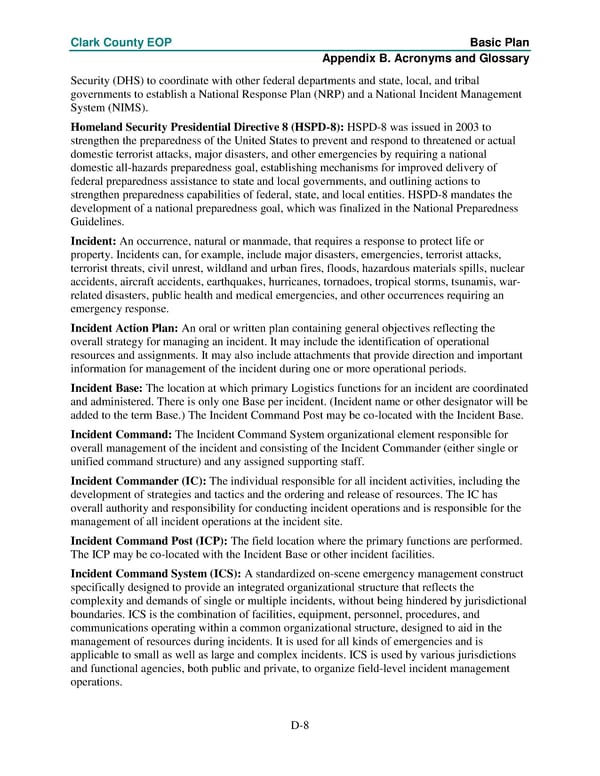Clark County EOP Basic Plan Appendix B. Acronyms and Glossary Security (DHS) to coordinate with other federal departments and state, local, and tribal governments to establish a National Response Plan (NRP) and a National Incident Management System (NIMS). Homeland Security Presidential Directive 8 (HSPD-8): HSPD-8 was issued in 2003 to strengthen the preparedness of the United States to prevent and respond to threatened or actual domestic terrorist attacks, major disasters, and other emergencies by requiring a national domestic all-hazards preparedness goal, establishing mechanisms for improved delivery of federal preparedness assistance to state and local governments, and outlining actions to strengthen preparedness capabilities of federal, state, and local entities. HSPD-8 mandates the development of a national preparedness goal, which was finalized in the National Preparedness Guidelines. Incident: An occurrence, natural or manmade, that requires a response to protect life or property. Incidents can, for example, include major disasters, emergencies, terrorist attacks, terrorist threats, civil unrest, wildland and urban fires, floods, hazardous materials spills, nuclear accidents, aircraft accidents, earthquakes, hurricanes, tornadoes, tropical storms, tsunamis, war- related disasters, public health and medical emergencies, and other occurrences requiring an emergency response. Incident Action Plan: An oral or written plan containing general objectives reflecting the overall strategy for managing an incident. It may include the identification of operational resources and assignments. It may also include attachments that provide direction and important information for management of the incident during one or more operational periods. Incident Base: The location at which primary Logistics functions for an incident are coordinated and administered. There is only one Base per incident. (Incident name or other designator will be added to the term Base.) The Incident Command Post may be co-located with the Incident Base. Incident Command: The Incident Command System organizational element responsible for overall management of the incident and consisting of the Incident Commander (either single or unified command structure) and any assigned supporting staff. Incident Commander (IC): The individual responsible for all incident activities, including the development of strategies and tactics and the ordering and release of resources. The IC has overall authority and responsibility for conducting incident operations and is responsible for the management of all incident operations at the incident site. Incident Command Post (ICP): The field location where the primary functions are performed. The ICP may be co-located with the Incident Base or other incident facilities. Incident Command System (ICS): A standardized on-scene emergency management construct specifically designed to provide an integrated organizational structure that reflects the complexity and demands of single or multiple incidents, without being hindered by jurisdictional boundaries. ICS is the combination of facilities, equipment, personnel, procedures, and communications operating within a common organizational structure, designed to aid in the management of resources during incidents. It is used for all kinds of emergencies and is applicable to small as well as large and complex incidents. ICS is used by various jurisdictions and functional agencies, both public and private, to organize field-level incident management operations. D-8
 Emergency Operations Plan Page 111 Page 113
Emergency Operations Plan Page 111 Page 113